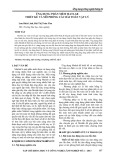
Characterization of a monoclonal antibody as the first
specific inhibitor of human NTP diphosphohydrolase-3
Partial characterization of the inhibitory epitope and potential
applications
Mercedes N. Munkonda
1
, Julie Pelletier
1
, Vasily V. Ivanenkov
2
, Michel Fausther
1
, Alain Tremblay
1
,
Beat Ku
¨nzli
3
, Terence L. Kirley
2
and Jean Se
´vigny
1
1 Centre de Recherche en Rhumatologie et Immunologie, Centre Hospitalier Universitaire de Que
´bec, Universite
´Laval, Canada
2 Department of Pharmacology and Cell Biophysics, College of Medicine, University of Cincinnati, OH, USA
3 Department of General Surgery, Universita
¨tMu
¨nchen, Germany
Plasma membrane-bound nucleoside triphosphate
diphosphohydrolase-1, 2, 3 and 8 (NTPDase1, 2, 3
and 8) control nucleotide levels at the cell surface by
hydrolyzing the cand bphosphates of nucleotides
[1,2]. These enzymes appear to play key roles in the
modulation and termination of P2 receptor signaling,
as demonstrated for NTPDase1 and NTPDase2 [3–10].
Other NTPDases, such as NTPDase4, 5, 6 and 7, are
Keywords
ATP; immunological techniques; inhibitor;
monoclonal antibody; NTPDase
Correspondence
J. Se
´vigny, Centre de Recherche en
Rhumatologie et Immunologie, Centre
Hospitalier Universitaire de Que
´bec (CHUQ),
2705 Boulevard Laurier local T1-49, Que
´bec,
QC G1V 4G2, Canada
Fax: +1 418 654 2765
Tel: +1 418 654 2772
E-mail: jean.sevigny@crchul.ulaval.ca
(Received 19 September 2008, revised 11
November 2008, accepted 12 November
2008)
doi:10.1111/j.1742-4658.2008.06797.x
The study and therapeutic modulation of purinergic signaling is hindered
by a lack of specific inhibitors for NTP diphosphohydrolases (NTPDases),
which are the terminating enzymes for these processes. In addition, little is
known of the NTPDase protein structural elements that affect enzymatic
activity and which could be used as targets for inhibitor design. In the
present study, we report the first inhibitory monoclonal antibodies specific
for an NTPDase, namely human NTPDase3 (EC 3.6.1.5), as assessed by
ELISA, western blotting, flow cytometry, immunohistochemistry and inhi-
bition assays. Antibody recognition of NTPDase3 is greatly attenuated by
denaturation with SDS, and abolished by reducing agents, indicating the
significance of the native conformation and the disulfide bonds for epitope
recognition. Using site-directed chemical cleavage, the SDS-resistant parts
of the epitope were located in two fragments of the C-terminal lobe of
NTPDase3 (i.e. Leu220–Cys347 and Cys347–Pro485), which are both
required for antibody binding. Additional site-directed mutagenesis
revealed the importance of Ser297 and the fifth disulfide bond (Cys399–
Cys422) for antibody binding, indicating that the discontinuous inhibitory
epitope is located on the extracellular C-terminal lobe of NTPDase3. These
antibodies inhibit recombinant NTPDase3 by 60–90%, depending on the
conditions. More importantly, they also efficiently inhibit the NTPDase3
expressed in insulin secreting human pancreatic islet cells in situ. Because
insulin secretion is modulated by extracellular ATP and purinergic
receptors, this finding suggests the potential application of these inhibitory
antibodies for the study and control of insulin secretion.
Abbreviations
ACR, apyrase conserved regions; HEK, human embryonic kidney; HRP, horseradish peroxidase; NTCB, 2-nitro-5-thiocyanatobenzoic acid;
NTPDase, NTP diphosphohydrolase; PVDF, poly(vinylidene difluoride).
FEBS Journal 276 (2009) 479–496 ª2008 The Authors Journal compilation ª2008 FEBS 479






























